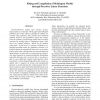Free Online Productivity Tools
i2Speak
i2Symbol
i2OCR
iTex2Img
iWeb2Print
iWeb2Shot
i2Type
iPdf2Split
iPdf2Merge
i2Bopomofo
i2Arabic
i2Style
i2Image
i2PDF
iLatex2Rtf
Sci2ools
87
Voted
ATAL
2004
Springer
2004
Springer
Fitting and Compilation of Multiagent Models through Piecewise Linear Functions
Decision-theoretic models have become increasingly popular as a basis for solving agent and multiagent problems, due to their ability to quantify the complex uncertainty and preferences that pervade most nontrivial domains. However, this quantitative nature also complicates the problem of constructing models that accurately represent an existing agent or multiagent system, leading to the common question, “Where do the numbers come from?” In this work, we present a method for exploiting knowledge about the qualitative structure of a problem domain to automatically derive the correct quantitative values that would generate an observed pattern of agent behavior. In particular, we propose the use of piecewise linear functions to represent probability distributions and utility functions with a structure that we can then exploit to more efficiently compute value functions. More importantly, we have designed algorithms that can (for example) take a sequence of actions and automatically ...
| Added | 30 Jun 2010 |
| Updated | 30 Jun 2010 |
| Type | Conference |
| Year | 2004 |
| Where | ATAL |
| Authors | David V. Pynadath, Stacy Marsella |
Comments (0)

